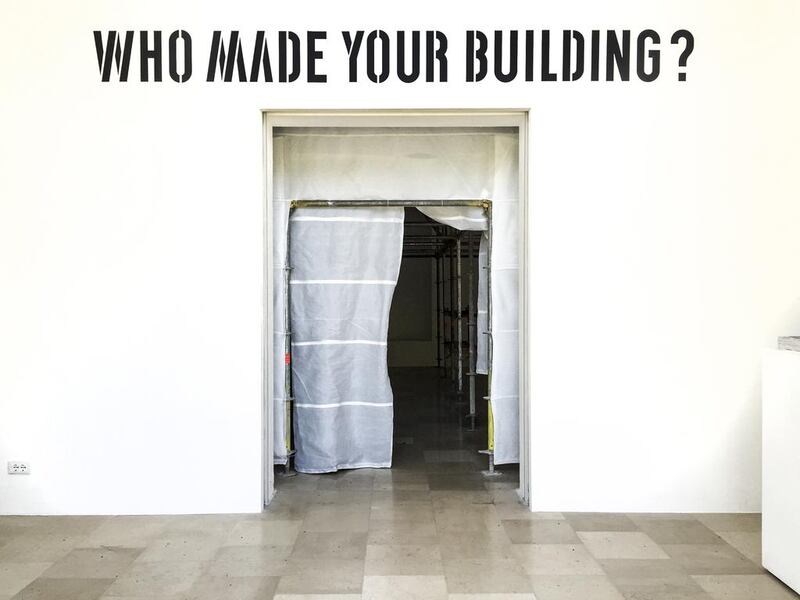Today we continue the series of reports brought to us from the Venice Architecture Biennale, currently underway in the Italian city. Every month, the UAE sends a handful of interns to man the National Pavilion at this world-class event and, for The Art Blog, some of those interns will contribute a report about another country’s pavilion of their choice. This report is about the National Pavilion of Poland and is written by Mays Albeik. Albeik is a Palestinian refugee of the third generation who was born and raised in the UAE. In 2014, Albeik was awarded the first runner-up in The Abu Dhabi Book Fair’s short story competition, and a place among the 12 fellows of the Salama Bint Hamdan Emerging Artist Fellowship. Albeik’s work has been shown in The Sharjah Art Foundation, Hunar Gallery, Sikka Art Fair, Tashkeel and Warehouse 411, part of the Salama bint Hamdan Al Nahyan Foundation. Her stories have been published by The National and The Outpost Magazine.
“WHO MADE YOUR BUILDING?”
The demand comes from the entrance into the National Pavilion of Poland, looming over all passers-by before any even enter the building.
The bold capital letters are printed on the pavilion overlooking one of the quieter parts of the Venice Biennale’s Giardini (the large park where many national pavilions are situated). The entrance is concealed by a hanging tarpaulin, half of it lifted for a glimpse into the dim interior. When you approach, you pick up on the noise that is spilling out, and once you enter, you are transported far from the beautiful Venetian summer morning.
I knew I wanted to write about this pavilion for a simple reason: in it architecture is both the medium and the content. This year’s Architecture Biennale’s curator, Alejandro Aravena, named the theme “Reporting From the Front”, focusing on the connections between architecture and the society occupying it. This is in contrast to previous editions where advancements in the field were the main focus and the pavilions aimed to shock and awe, leaving the event saturated with one-liners. This thematic shift produced exhibitions that were full of cold academic data, diagrams, models and drawings that were reminiscent of the final days of a semester in an architecture school. The Polish pavilion, among a handful of others, stood out not only for its immersive presentation, but for the relevancy of its content to the theme, and to the contemporary practices of architecture.
When you enter, you find yourself inside a scratched structure of aluminium scaffolding. Among the scaffolds hang five screens, each emitting sounds typical of an active building site. You are assailed by the visual cacophony of the aluminium lines around you, and the aural dissonances of welding, hammering, drilling, climbing, mixing and other tasks of a construction worker. In front of each screen is a simple wooden plank stretched between the aluminium, providing a surface to sit on and watch. The videos display point-of-view, vertigo-inducing footage of construction workers on the job, sometimes hundreds of metres in the air. A voice-over monologue for each video brings the view farther into the lives of these men as they discuss gruesome accidents on the job, over-time, payment issues, and the satisfaction of creating something that will be standing for decades after they are gone.
From among the scaffolds you also notice an opening onto a brighter room to the right. This room has the words “FAIR BUILDING”, in the same bold capitals, glaring at you on a yellow square from within. Stepping through, you leave the dim, claustrophobic space of the scaffolds, and enter a clean white room, the skylights above drenching it with sunlight. Two black leather couches sit facing opposite directions, one towards an infographic illustrating the human labour costs of a building – with scribbled lines providing additional commentary on the unethical work conditions of the relevant resources, the other towards a TV screen, displaying digital renderings of the buildings being put together, but with no humans in sight. The sounds of construction seep into this room, highlighting the evocative atmospheric contrast between the two spaces.
This installation, spatially, aurally and visually immersive (like all inhabited architecture) - did not point fingers, did not even promote solutions, but it displayed a problem potently, and brought forth the voices of “one of the most underrepresented participants in architecture: the construction worker.”
Find out more about Mays at www.maysalbeik.com and on instagram @maysalbeik. Follow the Venice Interns on on @veniceinerns and hashtags #uaeinvenice and #veniceinterns
aseaman@thenational.ae





